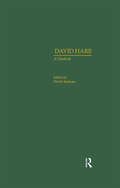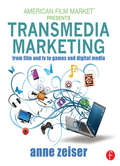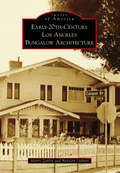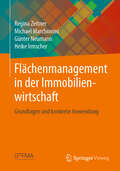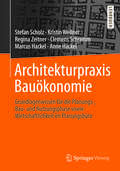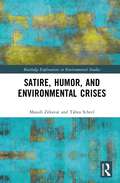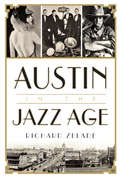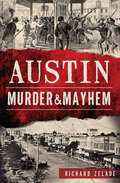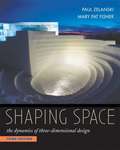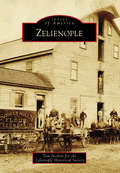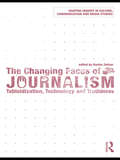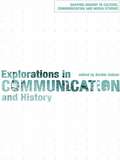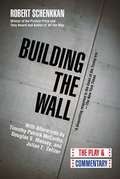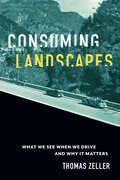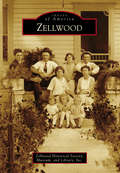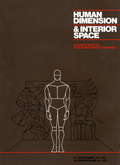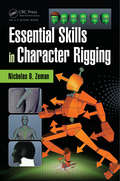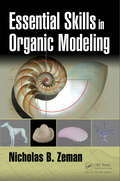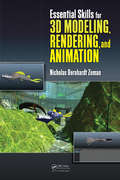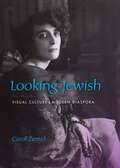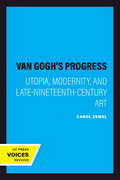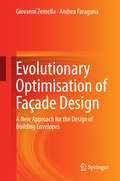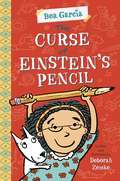- Table View
- List View
David Hare: A Casebook (Casebooks on Modern Dramatists #Vol. 18)
by Hersh ZeifmanLearning that David Hare has written sixteen stage plays, eight collaborations, and eleven screenplays for film and television, one might be surprised by the fact that this leading English artist is not yet fifty years old. He was only twenty-two when his first play was performed by the Portable Theatre, and he was a major voice on the British stage before he was thirty. The present volume is the first major collection of essays devoted to Hare, and its editor, Hersh Zeifman, who is a professor at York University, Toronto, is well-qualified to assemble and supervise such a significant undertaking. As co-editor of the prestigious journal, Modern Drama, he has been exposed to all the major authors and topics of modem theatre and is ideally positioned to discern Hare's pivotal role on the contemporary stage.
Sociology and Architectural Design (Social Science Frontiers)
by John ZeiselThis book, encouraging more effective collaboration between professional architects and social scientists, outlines how social science research can aid the design process, detailing how physical environment relates to behavior. With a foreword by Hugh F. Cline.
Transmedia Marketing: From Film and TV to Games and Digital Media (American Film Market Presents)
by Anne ZeiserTransmedia Marketing: From Film and TV to Games and Digital Media skillfully guides media makers and media marketers through the rapidly changing world of entertainment and media marketing. Its groundbreaking transmedia approach integrates storytelling and marketing content creation across multiple media platforms – harnessing the power of audience to shape and promote your story. Through success stories, full color examples of effective marketing techniques in action, and insight from top entertainment professionals, Transmedia Marketing covers the fundamentals of a sound 21st century marketing and content plan. You’ll master the strategy behind conducting research, identifying target audiences, setting goals, and branding your project. And, you’ll learn first-hand how to execute your plan’s publicity, events, advertising, trailers, digital and interactive content, and social media. Transmedia Marketing enlivens these concepts with: Hundreds of vibrant examples from across media platforms – The Hunger Games, Prometheus, The Dark Knight, Bachelorette, The Lord of the Rings, Despicable Me 2, Food, Inc., Breaking Bad, House of Cards, Downton Abbey, Game of Thrones, Top Chef, Pokémon, BioShock Infinite, Minecraft, Outlast, Titanfall, LEGO Marvel Super Heroes, Halo 4, Lonelygirl15, Annoying Orange Real-world advice from 45 leading industry writers, directors, producers, composers, distributors, marketers, publicists, critics, journalists, attorneys, and executives from markets, festivals, awards, and guilds Powerful in-depth case studies showcasing successful approaches – A.I. Artificial Intelligence, Mad Men, Lizzie Bennet Diaries, Here Comes Honey Boo Boo, and Martin Scorsese Presents the Blues Extensive Web content at www.transmediamarketing.com featuring a primer on transmedia platforms – film, broadcast, print, games, digital media, and experiential media; expanded case studies; sample marketing plans and materials; and exclusive interviews With Transmedia Marketing, you’ll be fully versed in the art of marketing film, TV, games, and digital media and primed to write and achieve the winning plan for your next media project.
Early-20th-Century Los Angeles Bungalow Architecture (Images of America)
by Harry Zeitlin Bennett GilbertLos Angeles, California, shaped the nation's culture in the 20th century with the city's bungalow style of mass middle-class housing. The style made the novelty and easy climate of Los Angeles into a force for living according to new standards of health and well-being, freedom and openness, and simple artistry. The bungalow combined the cozy appeal of Arts and Crafts design with what became the basic principles of 20th-century house architecture: earth-hugging lines, visible structure, and open floor plans emphasizing warmth, intimacy, and fluidity. While the streets and neighborhoods of the "bungalowtown" presented a lively panorama in which each house stood out as an individual, the bungalow was also a dream that the real estate industry sold to exploit the hunger for upward mobility that brought hundreds of thousands of new residents to the city during the three decades of the popularity of the style. Some of the neighborhoods that the developers established failed, and many homes were eventually demolished or in advanced decay. Yet today, these old houses are beautiful and comfortable homes when restored.
Flächenmanagement in der Immobilienwirtschaft: Grundlagen und konkrete Anwendung
by Regina Zeitner Michael Marchionini Günter Neumann Heike IrmscherDie Kenntnis der Bedeutung und korrekten Ausweisung von Flächen sind für das Facility Management einer Immobilie von großer Bedeutung.Dieses Buch führt in die Thematik des Flächenmanagements ein und gibt Aufschluss über richtige Ausweisung von Flächen in der Praxis. Für die wirtschaftliche Betrachtung einer Immobilie sind diese Angaben eine entscheidende Grundlage. Sie dienen zur Aufstellung des Raumprogramms, zur Kalkulation von Baukosten sowie zur Ermittlung der Einnahmen und Bewirtschaftungskosten. Flächenstandards, -flexibilität und -effizienz sind nicht nur in der gewerblichen Immobilienwirtschaft von Bedeutung. Das Benchmarking zur Bewertung von Flächen und Flächenkosten, die interne Leistungsverrechnung und die IT-Unterstützung für ein funktionierendes Flächenmanagement sind weitere wichtige Aspekte, die in diesem Buch behandelt werden.
Architekturpraxis Bauökonomie: Grundlagenwissen für die Planungs-, Bau- und Nutzungsphase sowie Wirtschaftlichkeit im Planungsbüro
by Regina Zeitner Stefan Scholz Kristin Wellner Clemens Schramm Marcus Hackel Anne HackelDiese Lehrbuch stellt das komplexe Tätigkeitsfeld des Architekten aus planungs- und bauökonomischer Sicht dar. Die Aufgaben des Architekten werden prozessorientiert im Sinne eines Qualitätsmanagementsystems vermittelt beginnend bei den Kernprozessen der Planung bis zur Realisierung des Bauvorhabens.
Satire, Humor, and Environmental Crises (Routledge Explorations in Environmental Studies)
by Massih Zekavat Tabea ScheelSatire, Humor, and Environmental Crises explores how satire and humor can be employed to address and mitigate ecological crises at individual and collective levels. Besides scientific and technological endeavors, solutions to ecological crises must entail social and communicative reform to persuade citizens, corporations, organizations, and policymakers to adopt more sustainable lifestyles and policies. This monograph reassesses environmental behavior and messaging and explores the promises of humorous and satiric communication therein. It draws upon a solid and interdisciplinary theoretical foundation to explicate the individual, social, and ecospheric determinants of behavior. Creative works of popular culture across various modes of expression, including The Simpsons, Last Week Tonight with John Oliver, and The New Yorker cartoons, are examined to illustrate the strong if underappreciated relationship between humor and the environment. This is followed by a discussion of the instruments and methodological subtleties involved in measuring the impacts of humor and satire in environmental advocacy for the purpose of conducting empirical research. More broadly, the book aspires to participate in urgent cultural and political discussions about how we can evaluate and intervene in the full diversity of environmental crises, engage a broad set of internal and external partners and stakeholders, and develop models for positive social and environmental transformations. This book will be of great interest to students and scholars interested in environmental humanities, communication science, psychology, and critical humor studies. It can further benefit environmental activists, policymakers, NGOs, and campaign organizers.
Austin in the Jazz Age
by Richard ZeladeThough renowned, Austin's contemporary music scene pales in comparison with the explosion of creative talent the city spawned during the Jazz Age. Dozens of musicians who started out in the capital city attained national and international fame--but music was just one form of artistic expression that marked that time of upheaval. World War I's death and destruction bred a vehement rejection of the status quo. In its place, an enthusiastic adherence to life lived without question or consequence took root. The sentiment found fertile soil in Austin, with the University of Texas at the epicenter. Students indulged in the debauchery that typified the era, scandalizing Austin and Texas at large as they introduced a freewheeling, individualistic attitude that now defines the city. Join author Richard Zelade in a raucous investigation of the day and its most outstanding and outlandish characters.
Austin Murder & Mayhem (Murder And Mayhem Ser.)
by Richard ZeladeAustin&’s past is as weird as its present—including murderous neighbors, deadly political antics, and a serial killer suspected to be Jack the Ripper. Beneath Austin&’s shiny veneer lies a dark past, filled with murder, lechery and deceit. Legislators, lawmen and lawyers killed, robbed and lied just as well and just as often as the drifters and grifters preying on newcomers. The nation&’s first known serial killer made his debut in Austin in the form of the Servant Girl Annihilator, who is still rumored to be Jack the Ripper. After the Willis brothers murdered their neighbors over rumored buried gold, a lynch mob hanged the boys from live oaks on present-day Sixth Street. Freshman representative Louis Franke died after he was robbed and beaten on the steps of the statehouse. Author Richard Zelade delivers a fascinating look at the seedier side of Austin history. Includes photos!
Shaping Space The Dynamics of Three-Dimensional Design 3rd Edition
by Paul Zelanski Mary Pat FisherThis book offers an engaging, in-depth exploration of the aesthetic and practical considerations of working three-dimensionally. It also includes new and expanded coverage of kinetic art, ephemeral and conceptual work, and works incorporating video and sound.
Zelienople
by Zelienople Historical Society Tom NesbittIn 1800, Butler County had just been created and was nothing but forest, streams, and Indian trails. Dettmar Basse purchased 10,000 acres in this wilderness, where he hoped to create a barony similar to the ones he had known in Germany. In 1802, he started to build his Bassenheim (Basse's home). It took seven years and $7,000 to build this castle, and he also laid out streets for a town that he named for his daughter Zelie (nople means village). Zelie and her new husband, Philippe Passavant, of French ancestry, traveled here in 1807 and became the first merchants on Main Street. Their son William A. Passavant founded numerous orphanages and hospitals throughout the country. Christian Buhl, the hatter and furrier, came to Zelienople from Germany in 1802. His grandson Henry Buhl Jr. founded Boggs and Buhl Department Store on the north side of Pittsburgh. In 1927, he bequeathed an $11-million endowment to the Buhl Foundation, making it one of the best-funded foundations in the country.
The Changing Faces of Journalism: Tabloidization, Technology and Truthiness (Shaping Inquiry in Culture, Communication and Media Studies)
by Barbie ZelizerThe collection is introduced with an essay by Barbie Zelizer and organized into three sections: how tabloidization affects the journalistic landscape; how technology changes what we think we know about journalism; and how ‘truthiness’ tweaks our understanding of the journalistic tradition. Short section introductions contextualise the essays and highlight the issues that they raise, creating a coherent study of journalism today.
Explorations in Communication and History (Shaping Inquiry in Culture, Communication and Media Studies)
by Barbie ZelizerWhen and how do communication and history impact each other? How do disciplinary perspectives affect what we know? Explorations in Communication and History addresses the link between what we know and how we know it by tracking the intersection of communication and history. Asking how each discipline has enhanced and hindered our understanding of the other, the book considers what happens to what we know when disciplines engage. Through a critical collection of essays written by top scholars in the field, the book addresses the engagement of communication and history as it applies to the study of technology, audiences and journalism. A comprehensive introduction by Barbie Zelizer contextualises these debates and makes a case for the importance of disciplinary engagement for teaching as well as research in media and cultural studies and each section has a brief introduction to contextualise the essays and highlight the issues they raise, making this an invaluable collection for students and scholars alike.
Building the Wall: The Play and Commentary (Oberon Modern Plays Ser.)
by Julian E. Zelizer Douglas S. Massey Robert Schenkkan Timothy Patrick McCarthyIn the tradition of Hamilton and Angels in America, a powerful, politically charged, dystopian drama that couldn’t be more timely. Written in a “white-hot fury” on the eve of the 2016 election, the stunning new play by Pulitzer Prize– and Tony Award–winning dramatist Robert Schenkkan is creating a nationwide sensation. Bypassing the usual development path for plays, it has been signed up to open in five theaters across America in a National New Play Network Rolling World Premiere, starting in Los Angeles (March) and Denver (April) and continuing in the Washington, DC, area, Tucson, and Miami, with more productions to follow, including in Santa Fe and New York City. Building the Wall lays out in a harrowing drama the consequences of Donald Trump’s anti-immigration campaign rhetoric turned into federal policy. Two years from now, that policy has resulted in the mass round-up of millions of illegal aliens, with their incarceration overflowing into private prisons and camps reminiscent of another century. The former warden for one facility is awaiting sentencing for what happened under his watch. In a riveting interview with a historian who has come seeking the truth, he gradually reveals how the unthinkable became the inevitable, and the faceless illegals under his charge became the face of tragedy. The play is accompanied by commentary from three prominent scholars: on the real purpose of the border wall, our dark nativist history of restricting immigration, and the tradition of political protest in art.
Consuming Landscapes: What We See When We Drive and Why It Matters
by Thomas ZellerWhat we see through our windshields reflects ideas about our national identity, consumerism, and infrastructure.For better or worse, windshields have become a major frame for viewing the nonhuman world. The view from the road is one of the main ways in which we experience our environments. These vistas are the result of deliberate historical forces, and humans have shaped them as they simultaneously sought to be transformed by them. In Consuming Landscapes, Thomas Zeller explores how what we see while driving reflects how we view our societies and ourselves, the role that consumerism plays in our infrastructure, and ideas about reshaping the environment in the twentieth century.Zeller breaks new ground by comparing the driving experience and the history of landscaped roads in the United States and Germany, two major automotive countries. He focuses specifically on the Blue Ridge Parkway in the United States and the German Alpine Road as case studies. When the automobile was still young, an early twentieth-century group of designers—landscape architects, civil engineers, and planners—sought to build scenic infrastructures, or roads that would immerse drivers in the landscapes that they were traversing. As more Americans and Europeans owned cars and drove them, however, they became less interested in enchanted views; safety became more important than beauty. Clashes between designers and drivers resulted in different visions of landscapes made for automobiles. As strange as it may seem to twenty-first-century readers, many professionals in the early twentieth century envisioned cars and roads, if properly managed, as saviors of the environment. Consuming Landscapes illustrates how the meaning of infrastructures changed as a result of use and consumption. Such changes indicate a deep ambivalence toward the automobile and roads, prompting the question: can cars and roads bring us closer to nature while deeply altering it at the same time?
Zellwood
by Zellwood Historical Society, Museum, and Library, Inc.Zellwood was named for Thomas Ellwood Zell, who arrived in the area in 1876. Zell sent scrapbooks displaying newspaper clippings to entice Northern friends--former Civil War officers--to settle near Lakes Maggiore and Minore. Word spread that Zellwood was a desirable place to winter and do business. Construction of millionaire steel magnate James Laughlin Jr.'s mansion began in 1885. Zellwood attracted people who built estates and new homes. Boardinghouses popped up. The Holly Arms Hotel and Zellwood Inn housed farmers, teachers, and entrepreneurs. In 1911, a train brought more settlers planning to earn their livelihood from Zellwood's rich earth. Agriculture dominated from the 1940s through the late 1990s. Zellwood was known for sweet corn. By 1999, all but one farm had been purchased for Lake Apopka restoration. Only Long and Scott Farms carries on the tradition of growing Zellwood sweet corn by farming the sandy soil bordering the muck lands of Lake Apopka.
Human Dimension and Interior Space
by Martin Zelnik Julius PaneroThe study of human body measurements on a comparative basis is known as anthropometrics. Its applicability to the design process is seen in the physical fit, or interface, between the human body and the various components of interior space.Human Dimension and Interior Space is the first major anthropometrically based reference book of design standards for use by all those involved with the physical planning and detailing of interiors, including interior designers, architects, furniture designers, builders, industrial designers, and students of design. The use of anthropometric data, although no substitute for good design or sound professional judgment should be viewed as one of the many tools required in the design process. This comprehensive overview of anthropometrics consists of three parts.The first part deals with the theory and application of anthropometrics and includes a special section dealing with physically disabled and elderly people. It provides the designer with the fundamentals of anthropometrics and a basic understanding of how interior design standards are established. The second part contains easy-to-read, illustrated anthropometric tables, which provide the most current data available on human body size, organized by age and percentile groupings. Also included is data relative to the range of joint motion and body sizes of children. The third part contains hundreds of dimensioned drawings, illustrating in plan and section the proper anthropometrically based relationship between user and space. The types of spaces range from residential and commercial to recreational and institutional, and all dimensions include metric conversions.In the Epilogue, the authors challenge the interior design profession, the building industry, and the furniture manufacturer to seriously explore the problem of adjustability in design. They expose the fallacy of designing to accommodate the so-called average man, who, in fact, does not exist. Using government data, including studies prepared by Dr. Howard Stoudt, Dr. Albert Damon, and Dr. Ross McFarland, formerly of the Harvard School of Public Health, and Jean Roberts of the U.S. Public Health Service, Panero and Zelnik have devised a system of interior design reference standards, easily understood through a series of charts and situation drawings. With Human Dimension and Interior Space, these standards are now accessible to all designers of interior environments.
Essential Skills in Character Rigging
by Nicholas B. ZemanCharacter rigging is the method with which you create a system for animating a character. A rig is represented by two primary mechanics: the skeleton, consisting of hierarchical rotations to drive the motions, and a skin, or method of deforming the geometry that makes up the character model. Essential Skills in Character Rigging is a beginner's gui
Essential Skills in Organic Modeling
by Nicholas B. ZemanThis is a beginner’s guide to learning and implementing the essential aspects of modeling organic objects and using an organic workflow to model anything. This book gives an aspiring modeler all the tools that they need to know in order to begin creating great models that are efficient and laid out properly for rigging and texturing. The reader will be taken through all the primary techniques and methodologies for making “liveable” creatures for video, film, or games. The reader will also learn the basic physical structure that designates something as organic vs artificial, and how these varying structures can be tackled from a modeling perspective.through a practical, hands-on approach. Features Designed to approach organic modeling in a software-independent manner. Builds fundamental knowledge of 3D digital art from the ground up. Each lesson builds on the previous lesson. Has industry standard knowledge, based on simplicity and efficiency that will work for either production rendering or game development. Defines what organic modeling is and how it works, and why each technique was developed and implemented as it currently stands.
Essential Skills for 3D Modeling, Rendering, and Animation
by Nicholas Bernhardt ZemanThe Key to Fully Understanding the Basics of a 3D WorldProminently used in games, movies, and on television, 3D graphics are tools of creation used to enhance how material and light come together to manipulate objects in 3D space. A game-changer written for the non-technical mind, Essential Skills for 3D Modeling, Rendering, and Animation examines
Environmental Challenges in Civil Engineering II (Lecture Notes in Civil Engineering #322)
by Zbigniew Zembaty Zbigniew Perkowski Damian Beben Maria Rossella Massimino Oren LavanThis book gathers a selection of papers presented at the 5th International Scientific Conference “Environmental Challenges in Civil Engineering”, ECCE 2022, held on September 26-28, 2022, in Opole, Poland. Written by an international group of experts, it reports on findings concerning structural material behavior, and new methods and technologies in constructions. A special emphasis is given to sustainable constructions practices, including material recycling and reuse, renovation and restoration of historical building and to those fostering sustainable development of cities and rural areas, and a better integration of buildings with the environment. Offering a good balance of theory and practice, and covering both technical and organizational aspects in civil engineering and architectural projects, this book offers extensive information on solutions and current challenges in construction projects and structural interventions in the context of environmental protection and earthquake prevention.
Looking Jewish: Visual Culture And Modern Diaspora
by Carol ZemelJewish art and visual culture--art made by Jews about Jews--in modern diasporic settings is the subject of Looking Jewish. Carol Zemel focuses on particular artists and cultural figures in interwar Eastern Europe and postwar America who blended Jewishness and mainstream modernism to create a diasporic art, one that transcends dominant national traditions. She begins with a painting entitled Albert: Used to Be Abraham, a double portrait of a man, which serves to illustrate Zemel's conception of the doubleness of Jewish diasporic art. She considers two interwar photographers, Alter Kacyzne and Moshe Vorobeichic; images by the Polish writer Bruno Schulz; the pre- and postwar photographs of Roman Vishniac; the figure of the Jewish mother in postwar popular culture (Molly Goldberg); and works by R. B. Kitaj, Ben Katchor, and Vera Frenkel that explore Jewish identity in a postmodern environment.
Van Gogh's Progress: Utopia, Modernity, and Late-Nineteenth-Century Art (California Studies in the History of Art #36)
by Carol ZemelThis title is part of UC Press's Voices Revived program, which commemorates University of California Press’s mission to seek out and cultivate the brightest minds and give them voice, reach, and impact. Drawing on a backlist dating to 1893, Voices Revived makes high-quality, peer-reviewed scholarship accessible once again using print-on-demand technology. This title was originally published in 1997.This title is part of UC Press's Voices Revived program, which commemorates University of California Press’s mission to seek out and cultivate the brightest minds and give them voice, reach, and impact. Drawing on a backlist dating to 1893, Voices Revived</DIV
Evolutionary Optimisation of Façade Design
by Giovanni Zemella Andrea FaragunaOptimization techniques offer immense potential for the improvement of performance-driven design, since they allow the adoption of an holistic approach. This can lead to great advantages: optimal design solutions can be properly identified only if all criteria are considered at the same time, rather than separately. There are two barriers which obstruct optimization from being applied to building design: a technological barrier (applying the algorithms is not easy and can be quite time-consuming) and a cultural one (architects and engineers are required to change their perspectives as the design process has to be handled in a new way). This book explores these barriers from the perspective of both engineers and architects, and proposes a change in the attitudes of these two "actors": an engineer and an architect develop a dialog which helps them understand each other's perspective; in this way they find how they must both make a step forward.
The Curse of Einstein's Pencil
by Deborah ZemkeBea’s artistic gifts lead to a special new friendship in book two of this funny illustrated chapter book series for fans of Amelia’s Notebook and Judy Moody Bea Garcia is looking for a new best friend, and she almost has one—the smartest girl in school, Judith Einstein. So when Einstein asks Bea to be her partner in the upcoming school geography contest, Bea is thrilled...at first. Schoolwork comes so easily to Einstein that Bea thinks the secret might be Einstein's special pencil. But when Bea takes Einstein's pencil home, it's not quite what she expected.
